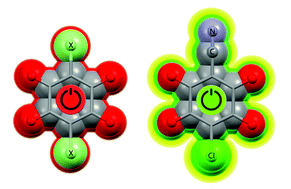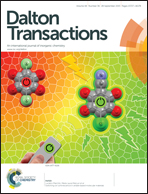Switching-on luminescence in anilate-based molecular materials†
Abstract
A simple change of one chloro substituent on the chloranilate ligand with a cyano group dramatically affects the electronic properties of the anilate moiety inducing unprecedented luminescence properties in the class of anilate-based ligands and their metal complexes. Here we report on the optimized synthesis and full characterization, including photoluminescence, of the chlorocyananilate ligand (ClCNAn2−) (dianion of the 3-chloro-6-cyano-2,5-dihydroxybenzoquinone, H2ClCNC6O4), a unique example of a heterosubstituted anilate ligand whose electronic properties, optical properties and coordination chemistry have never been investigated to date, even though it has been known since 1966. The synthesis and full characterization of its tris-chelated metal complexes with Cr(III), Fe(III), and Al(III) metal ions are also described herein. These complexes, formulated as [A]3[MIII(ClCNAn)3] (A = (n-Bu)4N+ or Ph4P+; MIII = Cr (3), Fe (4), Al (5)), are isostructural. While 3 and 4 are potential molecular building blocks for the preparation of molecule-based magnets or paramagnetic conducting organic–inorganic hybrid systems, 5, instead, where the coordinated Al(III) metal ions retain the luminescence of the ligand, represents a unique building block to achieve heterobimetallic assemblies showing emissive properties under visible light irradiation.


 Please wait while we load your content...
Please wait while we load your content...